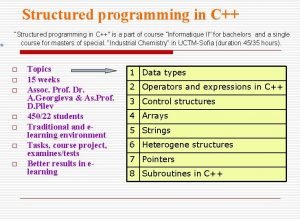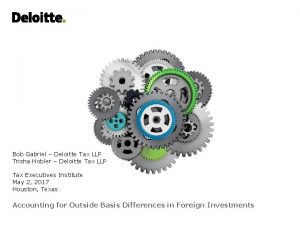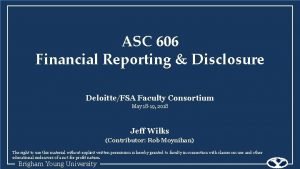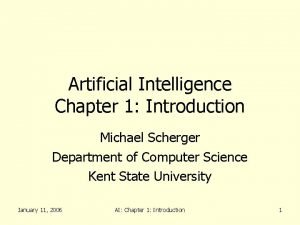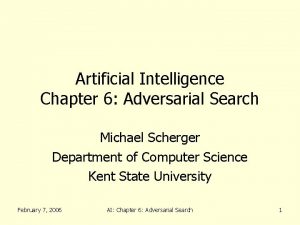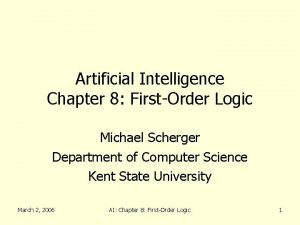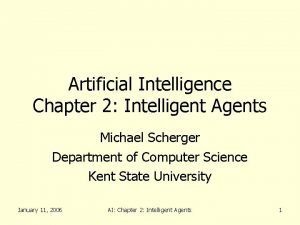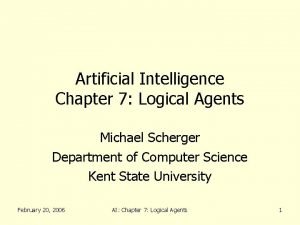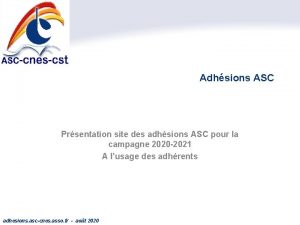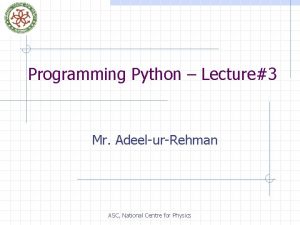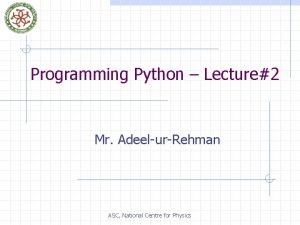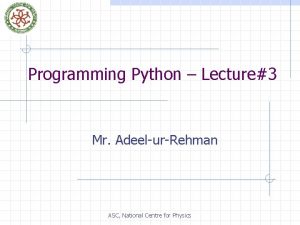ASC Programming Michael C Scherger Department of Computer
















- Slides: 16

ASC Programming Michael C. Scherger Department of Computer Science Kent State University September 27, 2002

Contents n n n n Software Location and Installation Basic Program Structure Data Types and Variables Associations and Setscope Input / Output Control Structures Looping Performance Monitor

Software n DOS/Windows, UNIX (Linux) ¨ Wave. Tracer ¨ Connection Machine ¨ n n Anyprog. asc Compiler and Emulator http: //zserver. cs. kent. edu/ PACL/downloads. htm Use any text editor. ¨ Careful moving files between DOS and UNIX! -e -wt -cm ASC Compiler Anyprog. iob -e -wt -cm ASC Emulator Standard I/O File I/O

Software n Example: ¨ To compile your program… ¨ ¨ To % asc 1. exe –e shapes. asc execute your program… % asc 2. exe –e shapes. iob ¨ % asc 2. exe –e shapes. iob < shapes. dat > shapes. out ¨

Basic Program Structure n Main program_name ¨ Constants; ¨ Varaibles; ¨ Associations; ¨ Body; n End;

Basic Program Structure n Example: ¨ Consider an ASC Program that computes the area of various simple shapes (circle, rectangle, triangle). Here is an example shapes. asc n Here is the data shapes. dat n Here is the shapes. out n

Data Types and Variables n ASC has eight data types… ¨ int, n real, hex, oct, bin, card, char, logical, index. Variables can either be scalar or parallel. ¨ Scalar variables are in the IS. Parallel variables are in the cells. ¨ Parallel variables have the suffix “[$]” at the end of the identifier. ¨ Can specify the length (in bits) of parallel variables. Default length works fine for most programs.

Data Types and Variables n n n int scalar a, b, c; int parallel p[$], q[$], r[$], pp[$, 4]; index parallel xx[$], yy[$]; n a+b a+p[$] a+p[xx] pp[xx, b]*3+q[$] p[xx]+pp[yy, b] q[$]+r[$] a+pp[xx, b]*3 n More Examples on page 9 -10 n n n scalar parallel scalar

Associations and Setscope n There are no “structs” or “classes” in ASC. ¨ Create an association between parallel variables and a parallel logical variables. n n Example on page 8. Setscope ¨ Selects n or “marks” a set of active cells. Example on page 15

Input / Output n READ ¨ Page 12 -13. ¨ Must have an ASSOCIATE statement. ¨ Input file must have blank line at end of data set. ¨ Read from “standard input” or from data file re -directed from command line.

Input / Output n PRINT ¨ Page 13 ¨ Must have an ASSOCIATE statement. ¨ Does not output user specified strings. I. e. User text messages. n Only outputs the values of parallel variables. n

Input / Output n MSG ¨ Page 13 -14 ¨ Used to display user text messages. ¨ Used to display values of scalar variables. ¨ Used to display a dump of the parallel variables.

Control Structures n IF-THEN-ELSE ¨ Scalar version similar to other sequential programming languages. n Either executes the body of the IF, OR executes the body of the ELSE. ¨ Parallel version is more “sequence-like”. Executes body of the IF followed by body of ELSE. n Masking operation. n

Control Structures Relational operators on page 40. n Example on page 16. n IF-NOT-ANY on page 16 -17. n ANY on page 17 -19. n

Looping n Sequential looping ¨ Loop-Until n Example on page 20. n Two types of parallel looping constructs: ¨ Parallel For-Loop n Conditional is evaluated only once. n Example on page 21. ¨ Parallel While-Loop n Conditional is evaluated every iteration. n Example on page 21 -22.

Performance Monitor n Keeps track of number of scalar and parallel operations. ¨ PERFORM = 1; ¨ PERFORM = 0; ¨ MSG PA_PERFORM; ¨ MSG SC_PERFORM;
 Structured programming in c
Structured programming in c Asc 740
Asc 740 Gem asc
Gem asc Academic success center
Academic success center Split bar major connector
Split bar major connector Asc cybersecurity
Asc cybersecurity Uninstalled materials asc 606
Uninstalled materials asc 606 Sfas 109
Sfas 109 Pier abutment male component
Pier abutment male component Asc 740-30-25-9
Asc 740-30-25-9 Asc college panvel
Asc college panvel Operating lease
Operating lease Asc 740-30-25-9
Asc 740-30-25-9 Asc 606 deloitte
Asc 606 deloitte Qué proyectos y talleres podemos crear asc
Qué proyectos y talleres podemos crear asc Asc 830
Asc 830 Suny oswego auxiliary services
Suny oswego auxiliary services
